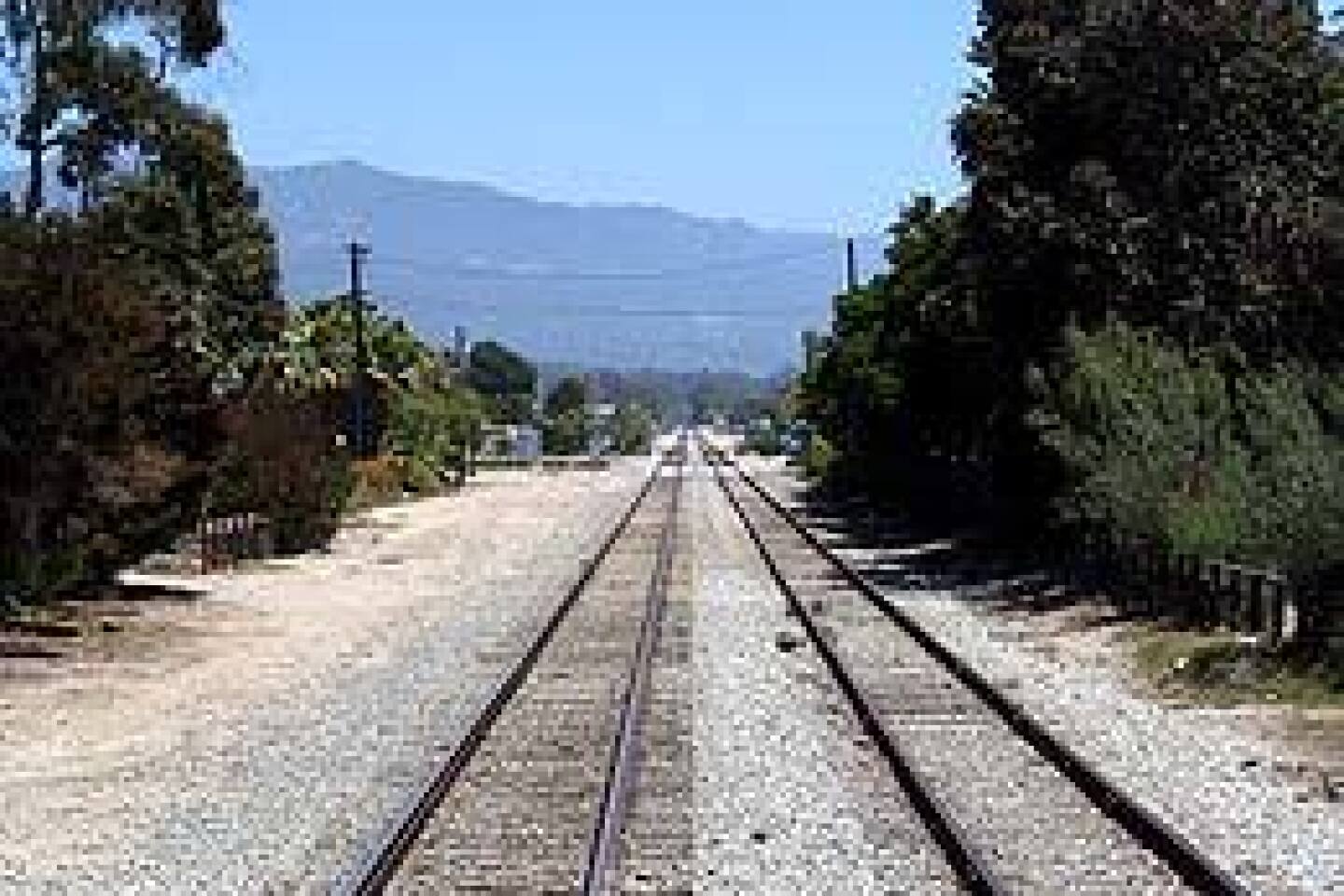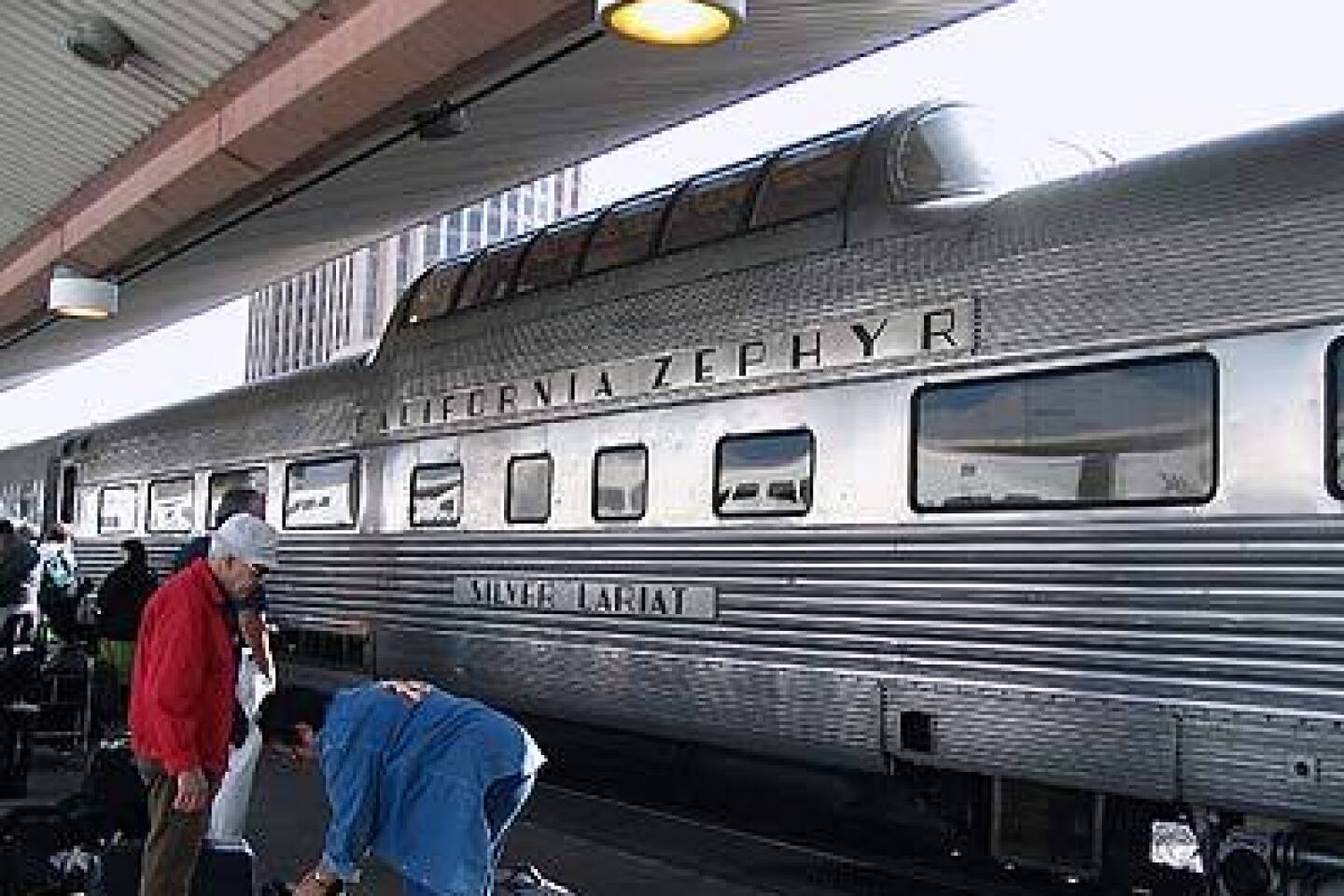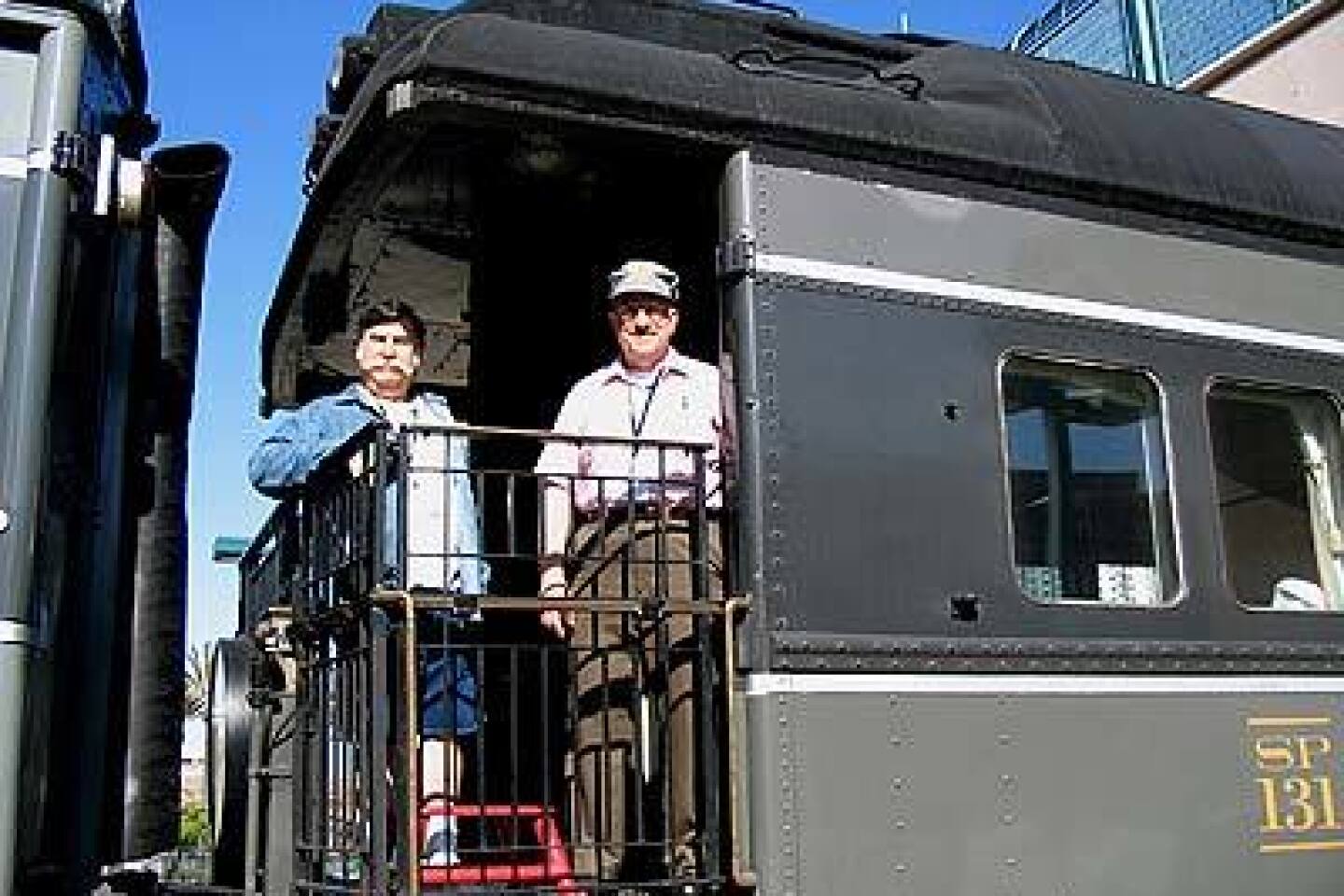It’s Not Just a Train Trip, It’s a State of Mind
- Share via
Man, did you see that wigwag back there? You don’t see many of those anymore.”
“And before that, three SW8s on a local “
“And those EMD switchers “ “Gaviota’s at 339.5, right?”
I catch snippets of this conversation among four casually dressed middle-aged men. The talk is lively, spirited, friendly—and completely incomprehensible. That’s because it’s in the coded language of those who live and breathe railroads. They call themselves “railfans,” but just about everyone else calls them “foamers”—as in foam at the mouth—a moniker that some embrace with humor while others consider an insult. Whatever they’re called, these railroad enthusiasts have elevated a staid and somewhat nerdy hobby to a grand obsession.
These four men are in foamer heaven right now, and I’m with them. We are aboard a special excursion train wending its way up the California coast on a lovely late spring afternoon, traveling in a style that most of us have never experienced. I am not now, nor have I ever been, a foamer, but I do love trains, and I have always regretted that I was born too late to enjoy any part of the long heyday (1880s-1950s) of long-distance rail travel. It was on a Los Angeles-to-Seattle trip last year that I encountered my first foamer, an earnest young man who bored me silly with railroad trivia and engineering statistics but also told me about an upcoming rail excursion—this one.
For the next two days, the 85 of us who have signed on for this L.A.-to-Oakland round trip will have the run of three lovingly restored passenger cars: a 1948 Vista-Dome, a 1927 lounge observation car and a 1941 Pony Express car. The cars, by special arrangement, are attached to the Coast Starlight, Amtrak’s daily Los Angeles-to-Seattle run.
Our trip is billed as a “rail cruise,” which, like an ocean cruise, is designed to be a travel experience dedicated to the journey rather than the destination. In the West, land of extraordinary vistas and wide-open spaces, rail cruises and private excursion trains are an increasingly popular close-to-home adventure for those who want to enjoy the landscape they usually fly over and experience the romance of train travel. The trip I am on, the Pacific Coast Limited, will be offered, with some variations, twice this fall, Oct. 22-24 and Nov. 5-7.
These rail cruises are the brainchild of Todd Clark, founder and webmaster of https://www.trainorders.com , one of the top foamer sites on the Internet, and most of those onboard are, like Todd, card-carrying (or, in this case, railroad insignia-wearing) foamers. Many are Californians, but others have come from as far away as Ohio, New Jersey, Tennessee and even New Zealand for the experience. The trip is not just an excursion along what is one of the most scenic stretches of railroad track in the country, not just a trip back in time to when railroad travel was elegant and refined, but a light romp through the psyches of those obsessed by trains.
The trip begins, fittingly, at one of the most impressive passenger train stations in the country, Los Angeles’ Union Station, a quirky blend of Spanish and Art Deco architecture noteworthy for its palatial waiting room and lovely outdoor gardens.
First opened to travelers in 1939, it was the last of the grand-scale train stations to be built in America. Today it is the nation’s sixth busiest, but that’s because of commuter, not long-distance, trains.
We depart on time, 10:15 a.m., and as the train slowly makes its way through the urban landscape, skirting the concrete-lined Los Angeles River, I take a tour of our three vintage cars.
At the rear of the train is the Los Angeles, a luxury car built by the famous Pullman Co. in 1927. It is elegant and posh, designed as a Gilded Age hotel on rails. It has two first-class bedrooms with private baths; a secretary’s room (a necessity for the movie moguls and business magnates who regularly booked passage); a crew room to house the car’s porter and chef; a tiny, self-contained galley; a formal dining room with built-in breakfront and crystal chandelier; an elegant salon with overstuffed armchairs; and a large observation platform.
Three-quarters of a century ago, political candidates might have given speeches from this platform. Today it is packed with foamers, including a former physics professor from Massachusetts who flew cross-country to make this trip; a hip, young Berkeley grad who took a job he didn’t like when he discovered that his place of work was only 50 feet from the Southern Pacific Railroad track (he watches trains all day); and a man with a congenital liver disease who spent months planning this trip and coordinating his health treatments. He will need dialysis immediately when we get to our destination.
The next car is the Silver Lariat, a stainless-steel, bubble-topped glass Vista-Dome built in 1948 for the original California Zephyr, the Oakland-to-Chicago passenger train. It took the current owners, Burt Hermey and Al Bishop, five years to rebuild and refurbish this car, from its understated gray wool carpet and burgundy upholstery to the special-order antimacassars draped over the backs of the comfortable coach seats. The car is quiet. The seats are wide, the windows expansive.
Up a small flight of stairs is the dome with seating for 24 passengers and an unobstructed 180-degree vista. Up here I find a man who tells me he moved to Tehachapi, some 120 miles north of L.A., for one reason only: Forty freight trains go through that town every day. So far he has taken 25,000 slides of their comings and goings. Also in the dome are two longtime traveling buddies. They proudly admit to suffering from “railpox,” the disease for which they hope there is no cure. “We all have one-track minds,” one of them says. “Girlfriends come and girlfriends go,” the other philosophizes, “but the railroad remains.”
The third car is the Pony Express, one of the most unusual passenger cars in service in North America. The car was originally built in 1941 as transport for the Royal Canadian Mounted Police, and has been refurbished as an open-air party car. The four big cargo doors that allowed horses to enter now remain open—with protective railings—to give riders a wind-whipping-through-the-hair experience. The car’s interior has been redone in ash paneling to replicate an 1872 coach car. Along one side is a carved oak bar; the floor is parquet.
If these three cars never moved an inch, this still would be an adventure worth having. But we are moving, and I know exactly how fast—49.3 mph—because the Pony Express is equipped with a thoroughly modern global positioning satellite system. Next to me, one of the foamiest foamers onboard, a self-described technogeek named Derek Law, is keeping tabs on everything. He leans out the cargo doors to take digital photos, rushes back to the computer to download them and then, with a flurry of mouse clicks, posts the photos he just took on the https://www.trainorders.com website for the edification of those foamers not fortunate enough to be traveling with us.
I stand by the open cargo doors and watch as the Glendale station—a pearl-pink Spanish Colonial-Revival gem of a building—goes by, then the burnt hills of Simi Valley, then Oxnard and finally, at noon, the Pacific. The sun is glinting off the ocean; the air is cool and fresh. The surfers are out. It’s time for lunch.
Donnalee Clark, a former student of the culinary arts, a professional cake decorator, trip organizer and Todd Clark’s wife, is in charge of the food. This trip she has the assistance of Shawn Murphey, one of 12 full-time private rail-car chefs in the country. Those who have sampled train food during the last 20 years know that onboard cuisine ranges from inedible to on par with economy-class airline food. This is different. Working shoulder to shoulder in the 6-by-8-foot galley tucked beneath the Silver Lariat’s dome, the women have put together a casual buffet lunch that could be ordinary but isn’t. The deli sandwiches are made with Boar’s Head meats on artisan bread. The tomato slices have both color and, miraculously, taste. The potato salad is tangy and substantial. The fruit came onboard at our last stop, fresh Santa Clara River Valley oranges. Lunch is set out on the big oak bar in the Pony Express. I grab a plate and take it to one of the tables set up at the rear of the car.
The train now is barreling along the coast into Santa Barbara, and the open-air car smells of eucalyptus and escallonia and sea air. The jacaranda trees are in bloom, a brilliant purple. The bougainvilleas are scarlet red, the sky a cloudless blue. The sensory experience is vivid and immediate, like riding on a motorcycle or in a convertible. The track noise is loud and hypnotic. You could stand by the open doors all day in a meditative trance. Even some of the foamers have stopped taking pictures and started enjoying the moment.
That is, until the train comes to a sudden halt. There’s nothing unusual in this. The Coast Starlight, the train that’s hauling our three cars, makes frequent unplanned and sometimes lengthy stops, mostly to let freight trains go by. The train has such a sketchy on-time record that it’s affectionately known, among foamers and other knowledgeable travelers, as the Coast Starlate.
But no one is watching the clock on our excursion. In fact, the later the better. It just means more time to enjoy the onboard experience. There’s no freight this time, and the two dozen foamers in the Pony Express want to know exactly why we’ve stopped. They pull out their RadioShack scanners—standard foamer equipment along with mini-DVD cams, high-resolution digital cameras and California Region Timetables, the foamer bible that details every stretch of track, mile post by mile post—and listen intently as the engineers and conductors talk to one another.
Apparently one of the infrared sensors embedded in the track has detected a defect in one of the axles. This is exciting stuff. Which axle? Which car? What kind of defect? The foamers discuss this with the intensity of a group of physicians conferring over a particularly tricky case. Long, deliciously tense moments go by.
Then we hear on the scanner that the problem has been identified: It turns out that an air hose was somehow disconnected. Several foamers congratulate one another for figuring this out before the Amtrak conductors do.
We are in motion again, about 70 miles north of Santa Barbara on a spectacular 42-mile stretch of track that hugs the Pacific. This is coastline you cannot see from a car because we are traveling through Vandenberg Air Force Base, and there is no public road. I go to the Lariat and climb to a seat in the dome where I can have an unobstructed view. Everyone here has a camera pointed out the window. The ocean, flat and calm, stretches to the horizon in bands of purple, aquamarine, cobalt and indigo. The shore is undeveloped, deserted. Seabirds float on updrafts. I sit transfixed for more than an hour. I cannot remember the last time I have allowed myself to sit quietly like this. I think of the root of the word vacation, from the Latin vacare, to be empty, to be free.
North of Pismo Beach we turn away from the coastline, make a quick stop at San Luis Obispo and then start climbing. The track ascends over a hump of the Coast Range, gaining more than 1,000 feet in 11 miles. We are traveling between the pleats of deeply corrugated hills and pillowy pale green knolls dotted with live oak and eucalyptus.
“This is my idea of paradise,” the foamer next to me says. I think he means the landscape, but he doesn’t. He means the railroad’s famed Cuesta Grade, the two sweeping horseshoe curves we now are snaking around.
Our train doubles back on itself so we can see the two engines that are pulling us—the serial numbers of which are duly noted by every foamer onboard. Train trivia aside, it’s an impressive sight.
We follow the Salinas River north through the valley of the same name, past endless acres of orderly vineyards and vast stretches of geometric farmland planted in lettuce, cabbage, green onions, strawberries and artichokes. It’s enough to make one hungry—that and the fragrance of sautéed garlic and onions that has wafted its way into the dome.
Directly below in the galley, legs firmly planted as the train hits 70 mph, Donnalee and Shawn are working furiously and harmoniously on dinner. In an even smaller galley in the Los Angeles, two significant prime ribs have been roasting for much of the afternoon. Donnalee, who is Italian, also is making a meatless entrée, her home-made ziti with the family recipe marinara sauce. There’s a simple salad of organic mesclun greens and tiny pearl tomatoes.
Back in railroad’s golden age, uniformed waiters served elegant repasts such as escallops of veal piquante and lobster Americaine (think flaming cognac) on fine china. The tables were covered with damask cloths. The diners were dressed in evening clothes. This experience is quite different, but it’s still an occasion. Donnalee, direct from the galley, exhausted but miraculously of good cheer, stands behind the big oak bar in the Pony Express and dishes out the meal.
Eighty-five meals. We all file by, swaying gently side to side, our train legs under us, and get our plates filled—and I mean filled. The foamers have turned off their scanners, closed their laptops, stored their cameras and are seriously chowing down. The table talk is, of course, all railroad, and to an interested neophyte such as me—there are perhaps a dozen nonfoamers on board—it is alternately obscure and fascinating.
I learn railroad slang: A wigwag is an old swing signal, a hogger is an engineer, and a piglet is an engineer-in-training. We are traveling on private varnish (private passenger cars) past a hump yard (where railroad cars are added to trains). None of us are crumb-jumpers (those who hang around the station looking for a free lunch), but I’m betting a few of us are members of the Clickity-Clack Club (the Mile-High Club on rails).
I learn that foamers, given their singular obsession, are, in fact, a diverse group. Some are only interested in locomotives. Some specialize in signals, others in tunnels or trestles. Some love freights; others are partial to passenger trains. Some pledge their allegiance to the Southern Pacific, others to Burlington Northern. Most are history buffs, but there are those who are interested solely in the mechanics. A significant subgroup are model railroad enthusiasts—grown men who still play with their Lionel train sets.
The evening wears on, but the mood is as buoyant as it was when we boarded in L.A. It’s the combination of onboard camaraderie, spectacular scenery and good food. The trip is well-run, but it’s not slick. You feel taken care of but not handled. That’s because underneath the expert organization and the four-color brochures, this is a family affair. Todd Clark, the trip’s creator, is a hands-on guy who oversees, troubleshoots and schmoozes nonstop. He also helps serve meals and bus tables. In the galley is Donnalee. Mario, Donnalee’s father, is also on board and pitches in where needed. The seven-member crew keeping coffee pots full, snacks available, garbage collected and questions answered, all friends of Todd, are foamers enjoying a free trip in exchange for light duties.
When the train pulls into Oakland’s Jack London Square a few minutes after 10 p.m.—we are a little more than an hour late, which, in Coast Starlight terms, is very much on time—I am in no hurry to debark. I don’t want to break the spell woven by these long, lovely hours in limbo, a day spent traveling 478.5 rail miles (by foamer account) the way people used to travel when the railroad was king.
The crew takes care of the luggage as Todd hustles us onto waiting buses for a quick trip to the Woodfin Suite Hotel in Emeryville. There we will stay the night in comfortable, spacious accommodations, breakfast included, until, with great eagerness, we board the train the next morning for the journey back to L.A.
GUIDEBOOK
Riding the Rails in California
Upcoming excursions: The next Pacific Coast Limited rail cruises, round-trip excursions from Los Angeles to Oakland, are Oct. 22-24 and Nov. 5-7. Both trips include two full days of rail travel and one day in the Bay Area. The October trip includes an optional San Francisco Bay sailing cruise aboard the Hawaiian Chieftain Tall Ship.
Telephone numbers and prices: Contact Coast Rail at P.O. Box 1085, Canyon Country, CA 91386, (800) 350-3182 or online at https://www.coastrail.com . The mailing address is Coast Rail. Round-trip cost, double occupancy, is $599 per person ($699 single occupancy; $349 for a child, 4-17 years old, sharing an adult’s room). The optional Tall Ship excursion is $99 per person.
Getting there: Board the Pacific Coast Limited at Los Angeles’ Union Station or at Amtrak stations in Glendale, Simi Valley, Oxnard or Santa Barbara.
Where to stay: Included in the cost of the trip are overnight accommodations. Passengers on the October trip will stay at the Woodfin Suite Hotel in Emeryville; in November at the Waterfront Hotel, near Jack London Square in Oakland. Transportation to and from the train station to the hotels is provided.
Where to eat: Lunch and dinner are served onboard for the Friday trip north and the Sunday return. On the October trip, breakfast at the Woodfin is included in the price. Other meals are on your own.
More to Read
Sign up for Essential California
The most important California stories and recommendations in your inbox every morning.
You may occasionally receive promotional content from the Los Angeles Times.













